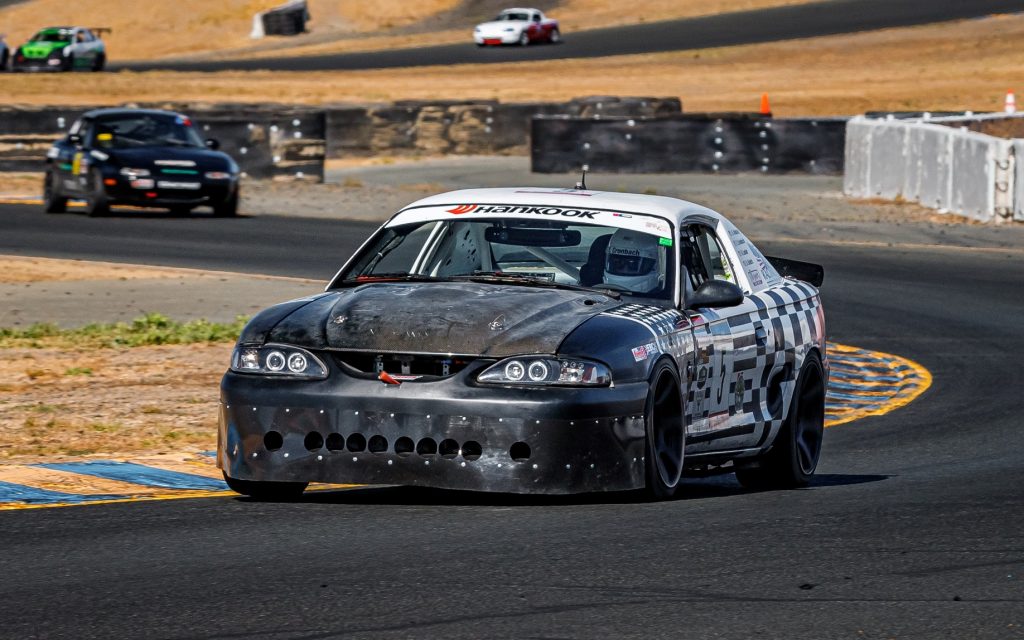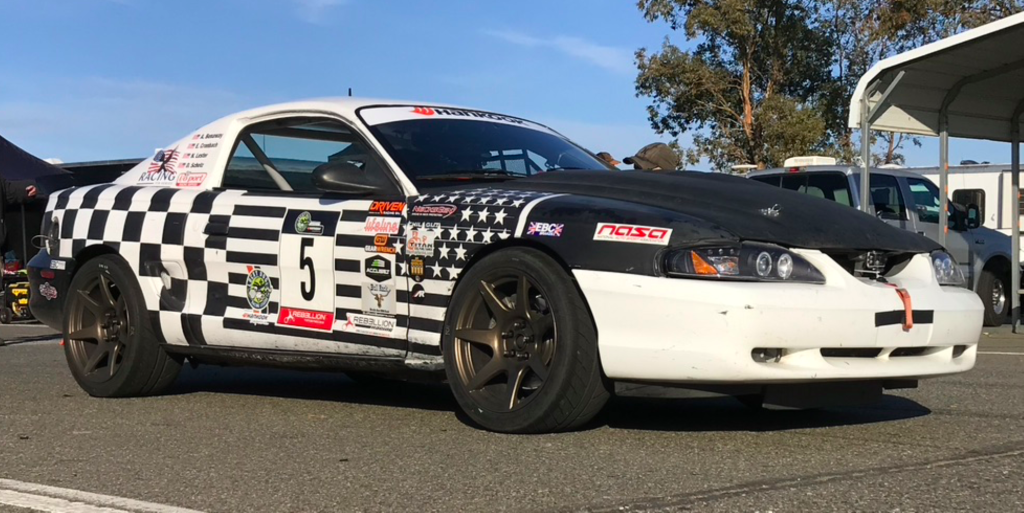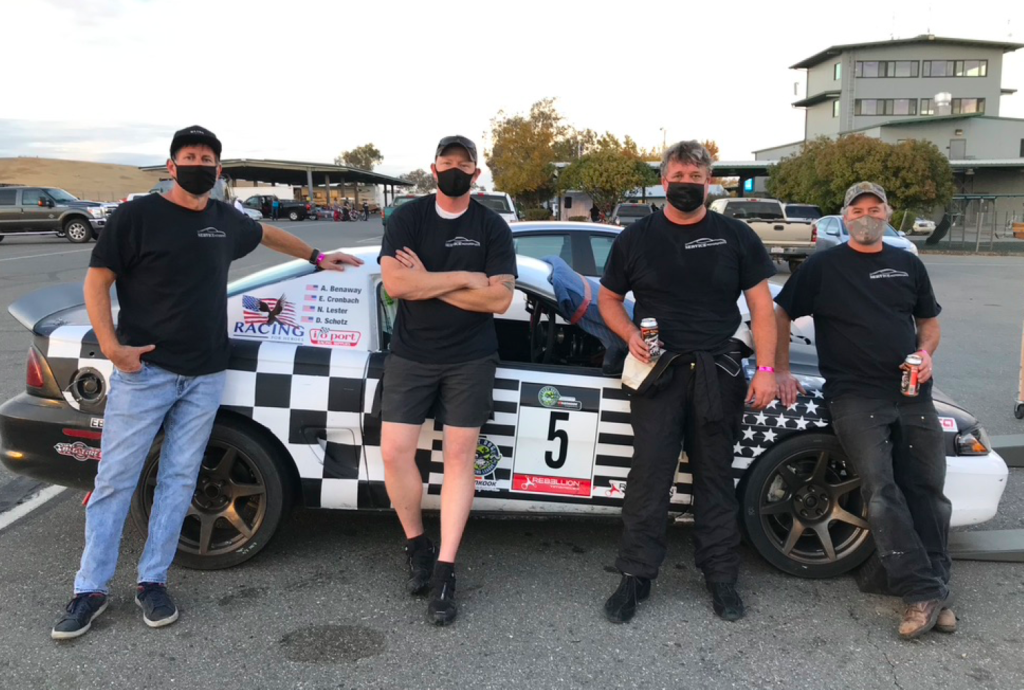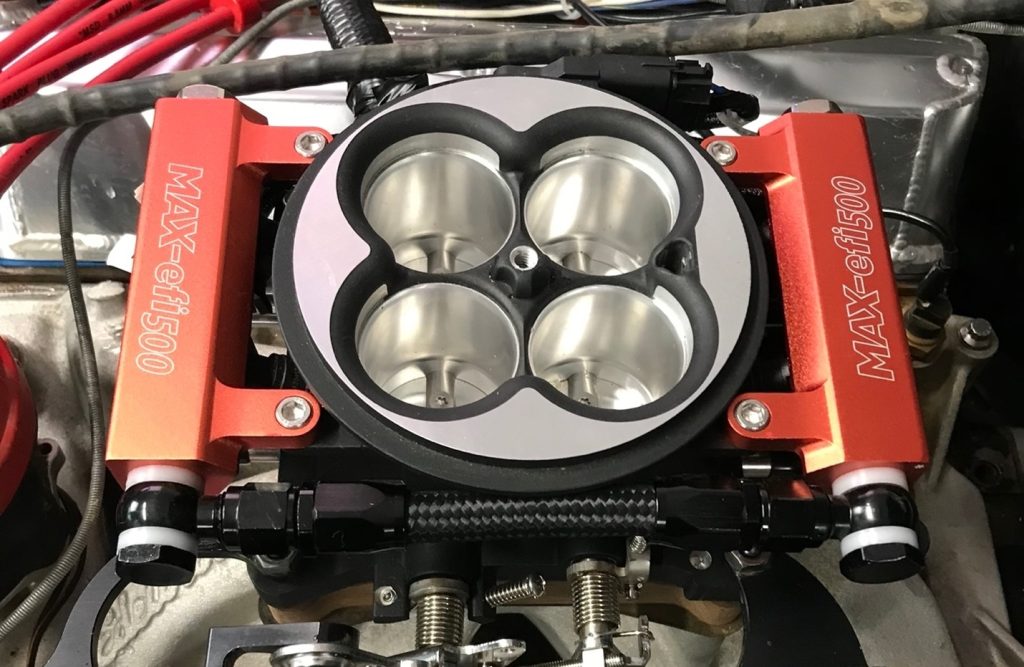
Summit Racing’s MAX-efi 500 electronic fuel injection system has proven itself as an affordable way to convert a carbureted street engine to EFI. Capable of handling up to 500 horsepower, the MAX-efi 500 is a throttle-body system that fits on most any four-barrel intake manifold with a squarebore mounting pattern. The self-tuning ECU continually adjusts fuel delivery to provide the optimum air/fuel ratio under all climate and altitude conditions, and has a self-adjusting “limp home” mode to protect your engine if a sensor fails.
But is the MAX-efi 500 a good alternative to a carburetor for racing?
On the face of it, the system’s ability to self-adjust fuel delivery, excellent throttle response, and smooth idle would make it ideal for a sportsman-level race car, especially for circle track and endurance road racing where the engine is subject to continuous throttle changes as the car goes through corners, S-turns, and chicanes.
Still, there was only one way to really find out—put it on a car and go racing.

As luck would have it, Eli Cronbach and the Service Motorsports team did just that. They run a 1995 Ford Mustang GT 5.0L in National Auto Sports (NASA) time trials and amateur endurance races, which are perfect venues for testing an EFI system.
Summit Racing gave the guys a MAX-efi 500 system, along with the recommended parts to convert the fuel system to support EFI, including a Summit Racing inline electric fuel pump, four-port fuel regulator, billet fuel filter, and a fuel pressure gauge.
Meet Service Motorsports
This isn’t your average race team. Its mission is to give U.S. military veterans, active-duty personnel, and public safety folks a way to experience racing firsthand.
“Racing and motorsports serve to reconnect us veterans with the team comradery, adrenaline, and purpose we all shared as part of our service experience,” Eli explained. “We also work to raise awareness for other organizations such as Racing for Heroes, Ranger Road, and Veterans on Track that support service members and veteran health.”
The team reflects this mission. Eli is a U.S. Coast Guard veteran, SCCA champion driver Adam Benaway is an active-duty sergeant with the U.S. Army’s 8th Special Operations Group; and lead mechanic Nathan Lester is the son of a U.S. Navy vet.

How did the MAX-efi 500 System Perform On the Track?
Eli can tell you in his own words:
***
This project started from a conversation with Summit Racing tech support about the performance of the MAX-efi 500 system in a race application. At the time, no one had tested or provided feedback to Summit Racing about using the system on a race car, so we offered to do so. Summit Racing supplied the system and we documented the installation, dyno testing, and on-track performance with our 1995 Ford Mustang GT.
Our team does NASA time trials and amateur endurance racing in the Lucky Dog Racing League. The car was conceived and designed for performance in endurance races ranging from seven to 24 hours in duration. As such, all-out horsepower was not a goal. Rather, we focused on a balance of performance, fuel economy, and reliability.
The engine is a 306 cubic inch small block Ford built in 2021 with these components:
- Factory Ford 302 roller cam block with .030 inch overbore
- 10.4:1 MAHLE forged pistons, Scat forged crankshaft and connecting rods
- Ford GT-40P iron heads with minor porting
- Schneider Racing roller camshaft, 286°/294° duration, 0.520″/0.528″ lift, 108° centerline
- Holley “NASCAR” 4150 carburetor, 390 CFM
- Edelbrock Victor Jr. intake manifold
- Ford RP GT40P headers
The Holley carburetor is heavily modified and has a wet flow rating of 610 CFM. The small butterflies keep velocity up through the venturis and produce a very responsive throttle with very little lag on throttle tip-in. The carbureted 302 had never let us down, but we were ready to explore the potential of an EFI system in our car.

Installation
Installing the MAX-efi 500 system was straightforward. The instructions that come with the kit are clear and made it easy to install and set up. One issue we encountered was that the system’s ECU seems to be very sensitive and requires ‘clean’ power. To boot up properly, the ECU positive (+Power) lead must have power all the time and before ignition power comes on. To ensure absolute reliability we did the following:
- +Power lead connected directly to the battery
- Ground lead connected directly to the battery, not a body ground or the engine. The engine is grounded directly to the battery as well
- Wired the +Key On lead to the ignition power input on our MSD ignition box via a Painless Wiring switch panel
The Max-efi 500 system requires a return-style fuel system generating 58 PSI of fuel pressure. We modified the Mustang’s fuel with these parts:
- Summit Racing Inline Fuel Pump, 340 LPH, 90 PSI
- Summit Billet Fuel Filter, 10 micron
- Summit Racing Adjustable 4-Port Fuel Pressure Regulator
- Summit Racing Fuel Pressure Gauge
After installing the system, we did the basic setup outlined in the instructions before making dyno pulls, which will allow the engine to start and go into learning mode:
- Number of cylinders
- Cubic inches
- Camshaft size (parameters provided in instructions)
- RPM limit
- Rev limit RPM (fuel cutoff)
- Electric fan control
There is an advanced tuning option that lets you set the target air/fuel ratio and other functions such as Idle Air Control open/close rate and Accel Pump, which allows you to adjust the amount of fuel delivered to the engine. We set the cam size at 4 and target A/F at 13.9. The system’s ECU does not control timing; we set ours at 29 degrees total.
Chassis Dyno
Before installing the Summit Racing MAX-efi 500 system, we tested the fresh motor with carburetor on the chassis dyno. It made 292 rear-wheel horsepower at 6,250 RPM and 278 lbs.-ft. of real-wheel torque at 4,680 RPM. Assuming an 18% powertrain loss, the motor was making about 355 horsepower at the crank—not bad for an iron-head 302.
After installing the MAX-efi 500 system we went back to the chassis dyno. The 302 made 320 rear-wheel horsepower at 6,250 RPM and 285 lbs.-ft. of rear-wheel torque at 5,200 RPM—a gain of 28 horsepower and 7 lbs.-ft. of torque. Assuming the same 18% powertrain loss, the engine was now making close to 390 horsepower at the crank.
At the Track
Our other questions could only be answered at the track. Would the switch to EFI upset the balance of power, reliability, and fuel economy we worked so hard to develop?
This past June, we ran the Mustang with the carbureted engine configuration at Sonoma Raceway, our home track with challenging 2.52-mile road course. The car ran perfectly just as it did the previous season. After the EFI conversion and dyno testing, we went back to the track to test the car. Here are the results:
- Idle: As expected, we noticed the engine started much easier with the Summit Racing EFI. Starting and warmup with the chokeless race carb was always a process. Now it was literally a touch of the starter switch and the motor settled into a rumbling idle. Even with our cam and single plane intake, the EFI system settled the motor into a relatively smooth idle at 900 RPM. With the carburetor, the engine would never idle below 1,150 RPM.
- Off-Idle (1st Gear): Throttle response was crisp with no hesitation or stumble.
- Cruise to Full Throttle (2nd Gear): Throttle response was excellent, with the additional horsepower generating rolling wheel spin if the throttle was applied too quickly. Throttle control was smooth, linear, and very easy to modulate.
- Corner Deceleration and Exit: Throttle response presented no issues, with no popping or backfire on deceleration and no bogging when getting back into the throttle. Response was a little soft in the lower RPMs as the EFI moved peak torque higher up in the powerband.
- Fuel Burn: Fuel burn in a race application is driven by car weight, horsepower, and lap pace. Our primary goal is to be able to run a full two-hour driver stint on the 24 gallon fuel load we are allowed. Using our average 2.02 minute lap time at Sonoma as the baseline, estimated fuel burn with EFI was 21 gallons vs. 20 gallons for our carbureted setup. We attribute the extra fuel burn to the increased horsepower.
Conclusions
I told Summit Racing we would share our honest opinion on the MAX-efi 500 system. Overall, we are very happy with it. The system has great out-of- the-box performance, and is a heck of a value for a budget-level race engine.
Since the MAX-efi 500 is designed as a plug-and-play system for the average enthusiast/racer, it does not support forced induction or nitrous, nor does it allow you to control ignition timing or an electronically-controlled automatic transmission. The system cannot be used with a digital dash, either. You can set up the handheld controller to view system parameters as data or as actual gauges.
As I write this, the 2021 racing season is over for us. Over the winter we will go back to the dyno to do more fine-tuning in preparation for the first endurance race of 2022, the “Revenge of the Underdogs” Ron Cortez Memorial Race in February at Sonoma Raceway. We will provide a follow-up story to let you know how we do!

[…] (Image/Service Motorsports) […]